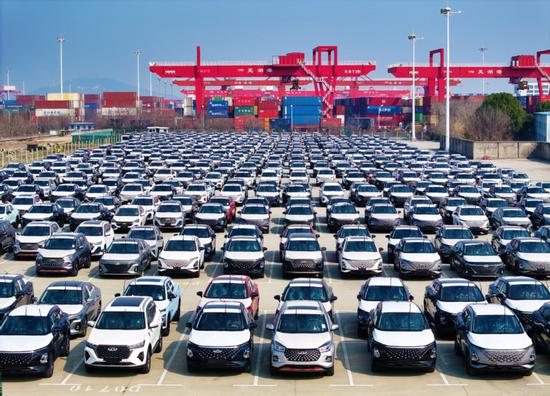
Biz leaders issue call to avoid cutthroat competition, embrace collaboration

Hundreds of vehicles line up at a port of Wuhu, Anhui province, on March 10, 2024, awaiting export. (WANG YUSHI/FOR CHINA DAILY)
Despite the challenging and highly complex nature of China-European Union negotiations on the latter’s anti-subsidy investigation into Chinese electric vehicles, such talks remain the most effective way to prevent the escalation of bilateral economic and trade tensions, said market watchers and business leaders.
To navigate the intensifying economic and trade competition, they said China and the EU should closely bind their industrial chains, enhance market integration and achieve mutual benefits.
As the Ministry of Commerce said in late June that China and the EU have expedited consultations on this issue, Lyu Yue, a professor at the Academy of China Open Economy Studies, part of the University of International Business and Economics in Beijing, said that through negotiations with the EU and discussions with relevant member states, China aims to reduce current tariff levels as much as possible.
By avoiding cutthroat competition and unilateral suppression, both sides should instead foster shared interests and prosperity, paving the way for a stronger, more collaborative economic future, Lyu said.
Even though Chinese EVs account for just a small share of the EU’s EV imports, the European Commission, which represents the interests of the EU as a whole, in mid-June unveiled additional provisional tariffs ranging from 17.4 percent to 38.1 percent for Chinese EV manufacturers.
The additional provisional EU duties on imported Chinese-made EVs are due to apply from Thursday, with the tariffs expected to be finalized on Nov 2.
According to its rules, the EU will implement “provisional tariffs” for four months before making a final decision. This means that from Thursday, when the EU starts imposing provisional tariffs — until the final tariff rates are determined — China has about four months to engage in talks with the EU and relevant member states.
Noting that there are different voices within the EU, Hu Zinan, a researcher at the German Studies Center of Tongji University in Shanghai, believes that such talks will be challenging, as the discussions will encompass more than just tariff levels on Chinese EVs exported to Europe.
Sharing similar views, Ding Rijia, a professor specializing in industrial economy at the China University of Mining and Technology in Beijing, said that if China retaliates with reciprocal tariffs, such as higher duties on large-displacement gasoline vehicle imports from Europe or restricted exports of critical materials like rare earths and lithium, it would severely drive up costs.
China-EU trade declined 1.3 percent year-on-year to 2.23 trillion yuan ($307 billion) in the first five months, statistics from the General Administration of Customs showed.
Matthias Loebich, partner and leader for international business at BearingPoint, a European management and technology consultancy with more than 10,000 employees across 70 countries and regions, said that China’s fast-growing EV sector will continue to lead the world’s green transition and create enormous growth opportunities for upstream and downstream industries in both domestic and global markets in the years ahead.
“This is evident in our doubling of Chinese automotive clients seeking consulting support over the past two years,” said Loebich, noting that Chinese automakers are enhancing their internal capabilities in management, digital transformation and overseas strategies, learning from advanced markets to elevate their global presence.
That sentiment is in line with the latest trend. China’s new energy vehicles are becoming popular in overseas markets thanks to their quality, driving range as well as multiple functionality.
A total of 519,000 EVs and plugin hybrids were shipped overseas from China between January and May, up 13.7 percent year-on-year, said the China Association of Automobile Manufacturers.








